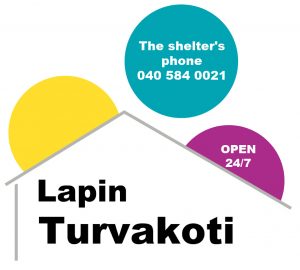 You can seek a place in the shelter when you experience domestic violence or a threat of it. The violence does not need to be physical, it may also be psychological, sexual or financial violence. Violence may start as name-calling, restricting the person or isolating the person from relationships and it may be difficult to identify it as violence.
You can seek a place in the shelter when you experience domestic violence or a threat of it. The violence does not need to be physical, it may also be psychological, sexual or financial violence. Violence may start as name-calling, restricting the person or isolating the person from relationships and it may be difficult to identify it as violence.
You can come to the shelter alone or together with your children. Your stay in the shelter is always free of charge to you and requires no referral. If your life is in danger, always call the emergency number 112.
Address: Lähteentie 5, 96400 Rovaniemi
Phone: 040 584 0021
Approximately 2 km from the train and bus station,
approximately 1 km from Rovaniemi city center
Frequently Asked Questions
The shelter provides professional support, help and safety. You can discuss your experiences and emotions related to violence in a calm and confidential environment with a staff member. Here you can peacefully reflect on and plan for the future with the assistance of the staff. Whenever possible, we aim to support your employment and your children’s daycare/schooling. In addition to counseling, we assist you with practical matters. For example, we can accompany you to various official appointments. Children also receive support in processing the situation at the shelter. We work in collaboration with the parent present at the shelter regarding the children.
The shelter is a temporary residence, and the duration of stay varies depending on the client’s situation. A plan for necessary continued support is made with you.
The shelter does not work with the perpetrator of violence. The perpetrator can receive help, for example, from our Association’s open services for domestic and violence work.
The shelter is intended for anyone who has experienced or is threatened by family or domestic violence and who needs help, support and temporary accommodation to cope with the situation. The fear or threat of domestic violence alone is sufficient reason to seek help. Violence does not always leave visible marks, and it can be difficult to recognize.
If you can leave to the shelter safely, pack clothes for yourself and your child, as well as important personal items (e.g., electronic devices, house keys, identification, hygiene products, medications, prescriptions, social security card, bank cards and any other necessary personal items).
- Physical violence such as hitting, choking, pushing, kicking, restraining or throwing objects.
- Psychological violence such as threats, name-calling, belittling, restricting, controlling, threatening with suicide or jealousy.
- Financial violence such as controlling money, economic inequality, preventing employment or forcing the surrender of personal finances to others.
- Sexual violence such as pressuring into sex or raping, sexual humiliation, denial of contraception, forced abortion or restricting sexual autonomy.
- Chemical violence such as intentionally harming someone’s physical or mental well-being with medication, substances, chemicals or solvents.
- Religious/cultural violence such as forcing someone into a religious belief, threatening or using violence based on religion or culture so-called honor violence.
- Stalking such as repeated unwanted contacts, spreading false information, property destruction, intimidation, surveillance, stealing and misuse of information.
- Threats of violence such as threatening with physical or sexual violence, psychological intimidation, blackmail or other threats.
The shelter is a homelike unit. It consists of seven apartments intended for families or individuals seeking shelter. We have seven crisis and violence specialized counselors and one coordinating social worker. The client has access to their own apartment as well as shared spaces within the shelter. Pets are not allowed in the shelter, but if needed, we can assist in finding temporary care for them.
The shelter is located on ground level. Drop-off traffic can reach the vicinity of the shelter’s entrance, about 10 meters away from the front door. The shelter’s parking lot is not immediately near to the entrance, and there are no accessible parking spaces. We will arrange an accessible parking space if necessary.
The entrance of the shelter has a flat paved pathway and is covered and well-lit. There is an doorbell and intercom at the shelter’s door for gaining entry.
There is one accessible client apartment in the shelter where you can move around easily with a walker or wheelchair. The accessible apartment’s bathroom has a sliding door, grab bars and a fixed shower chair. The kitchen in the apartment is designed for wheelchair accessibility. The apartment’s bedroom door and closets are equipped with sliding doors.
In the other client apartments, it is possible to move with smaller wheeled assistive devices such as a walker. The bathrooms in these apartments do not have aid equipment.
It is possible to enter the shelter with a personal assistant and/or guide dog or service dog.
For more detailed accessibility information about the shelter, you can inquire with the shelter’s staff by calling 040 584 0021.
The shelter on the map
Video Produced by the Finnish Institute for Health and Welfare:
Shelter’s brochures
In Finnish:THL_Turvakotien_yleisesite_210x210_4s_verkko
In English:THL_Turvakotien_yleisesite_210x210_4s_ENG_verkko

